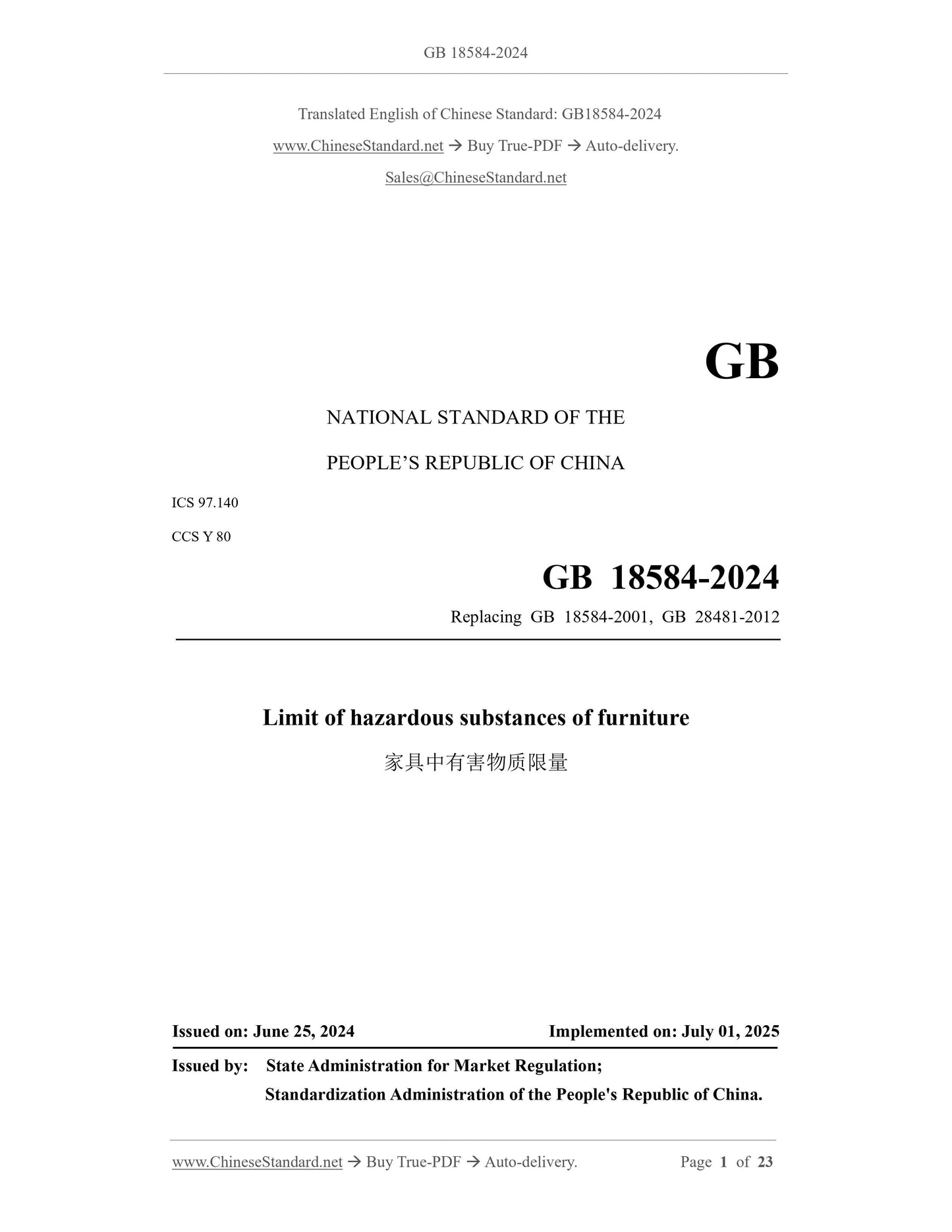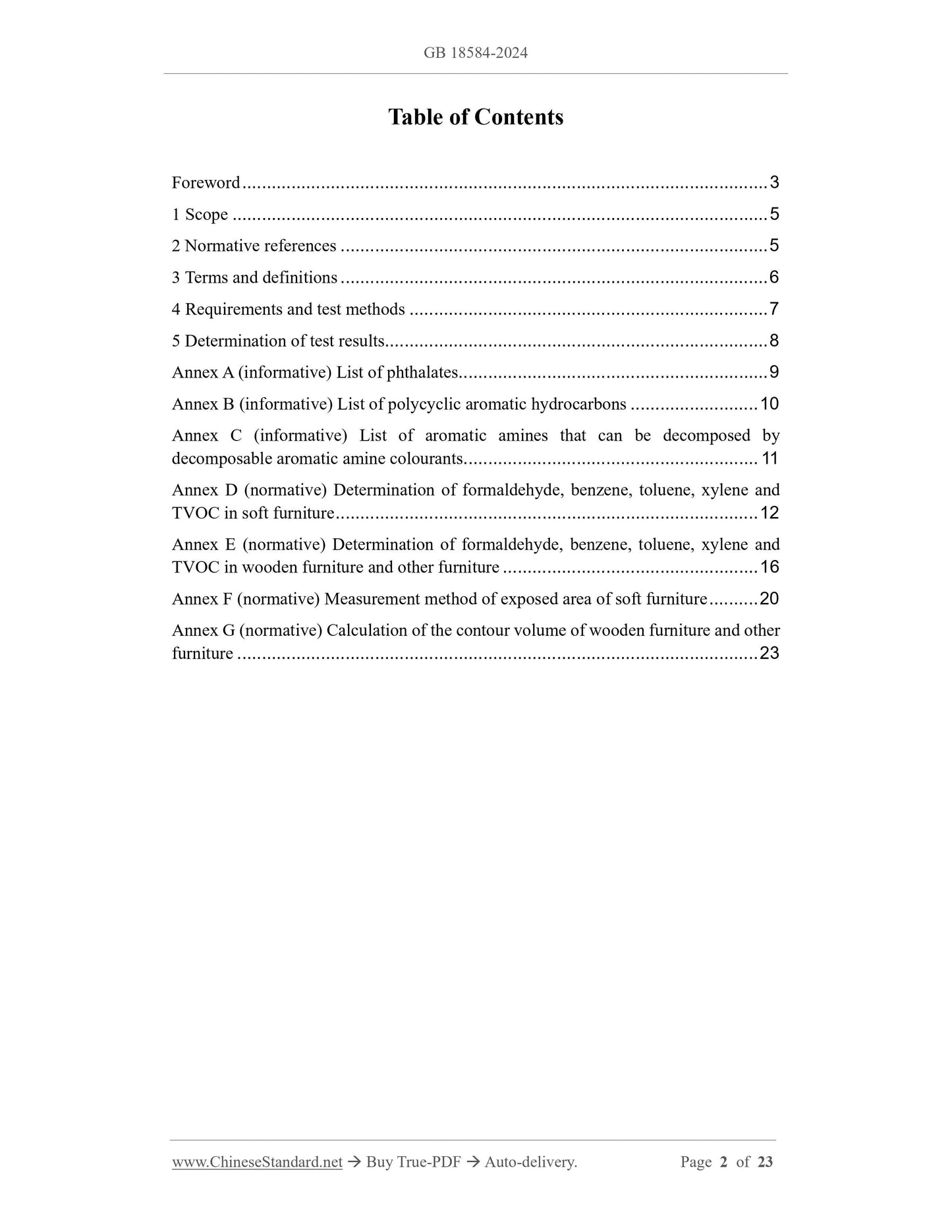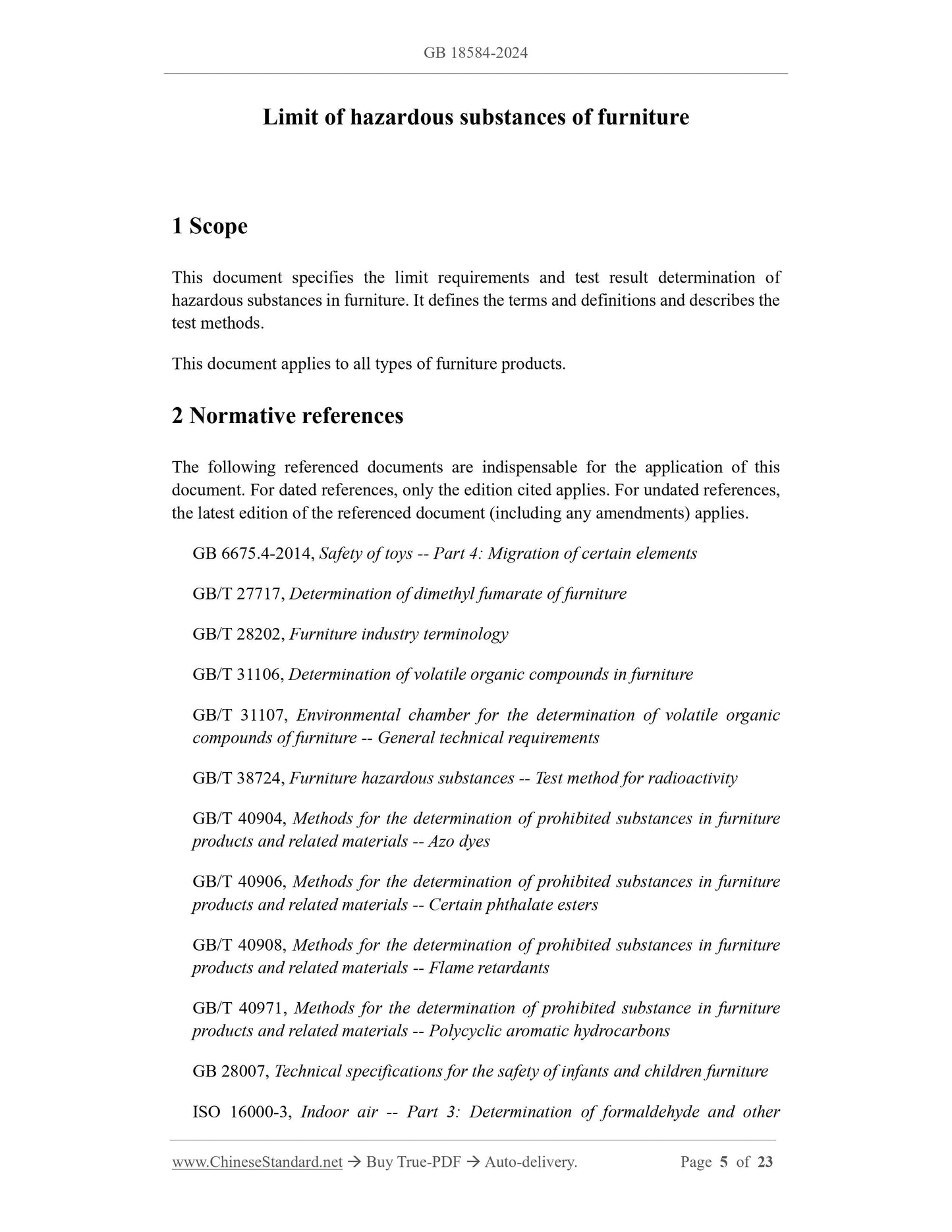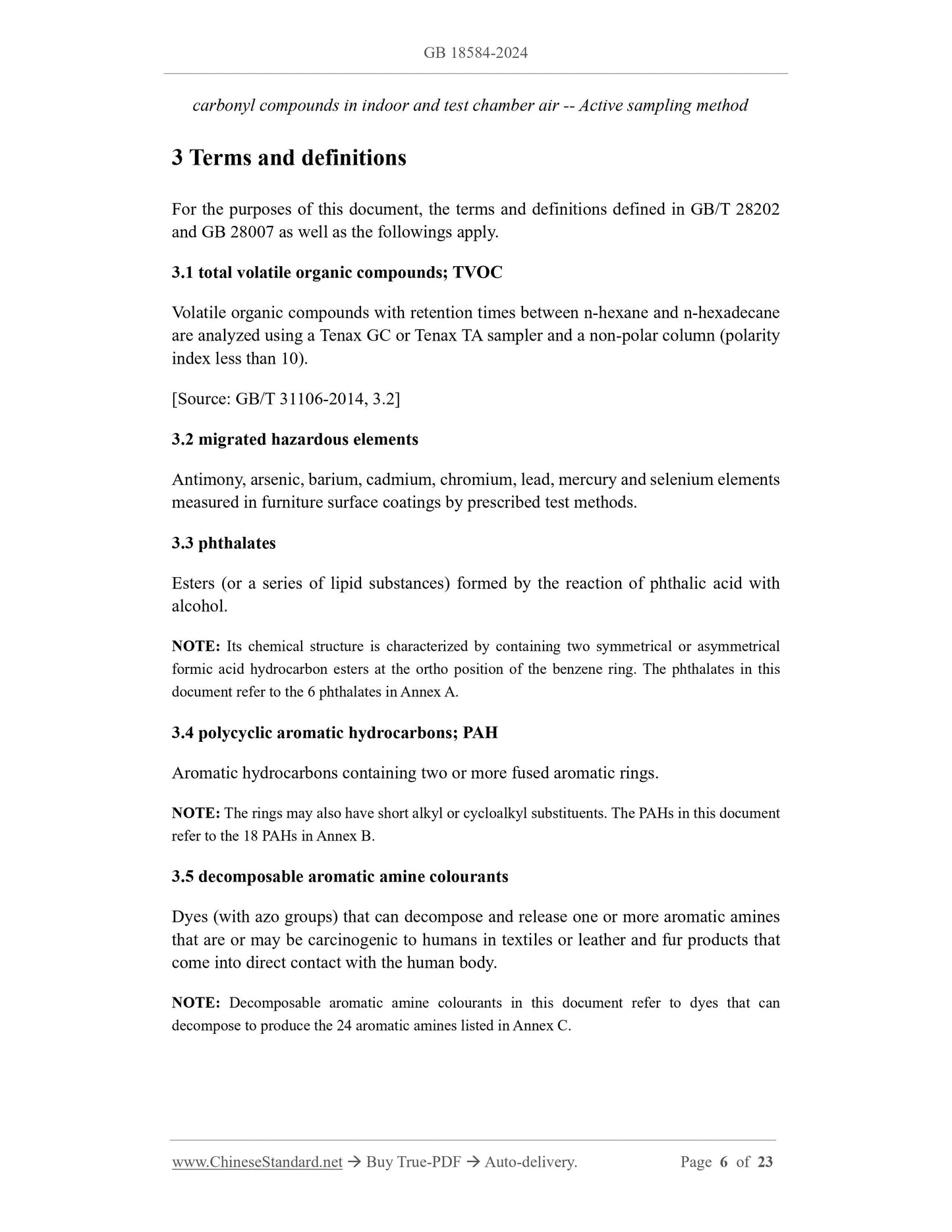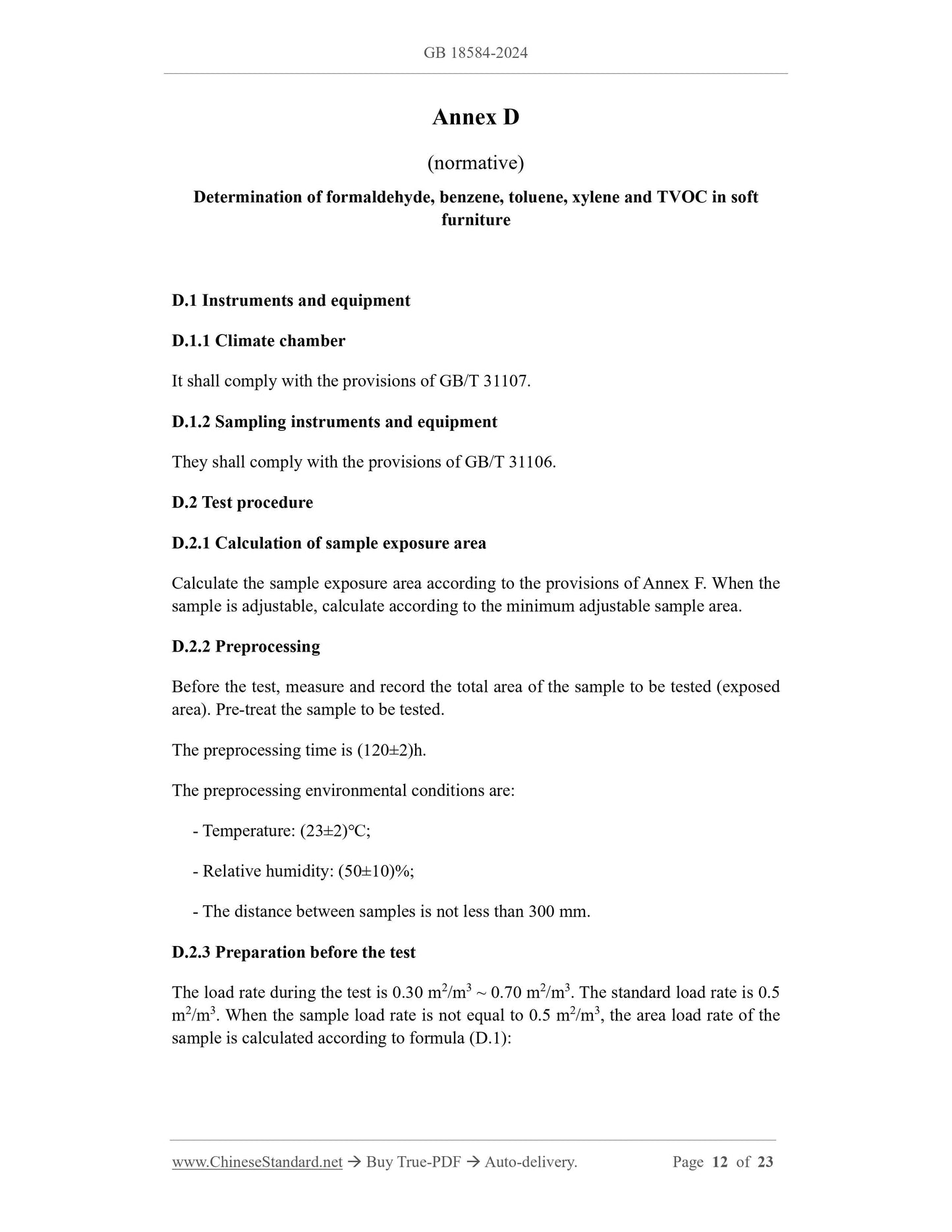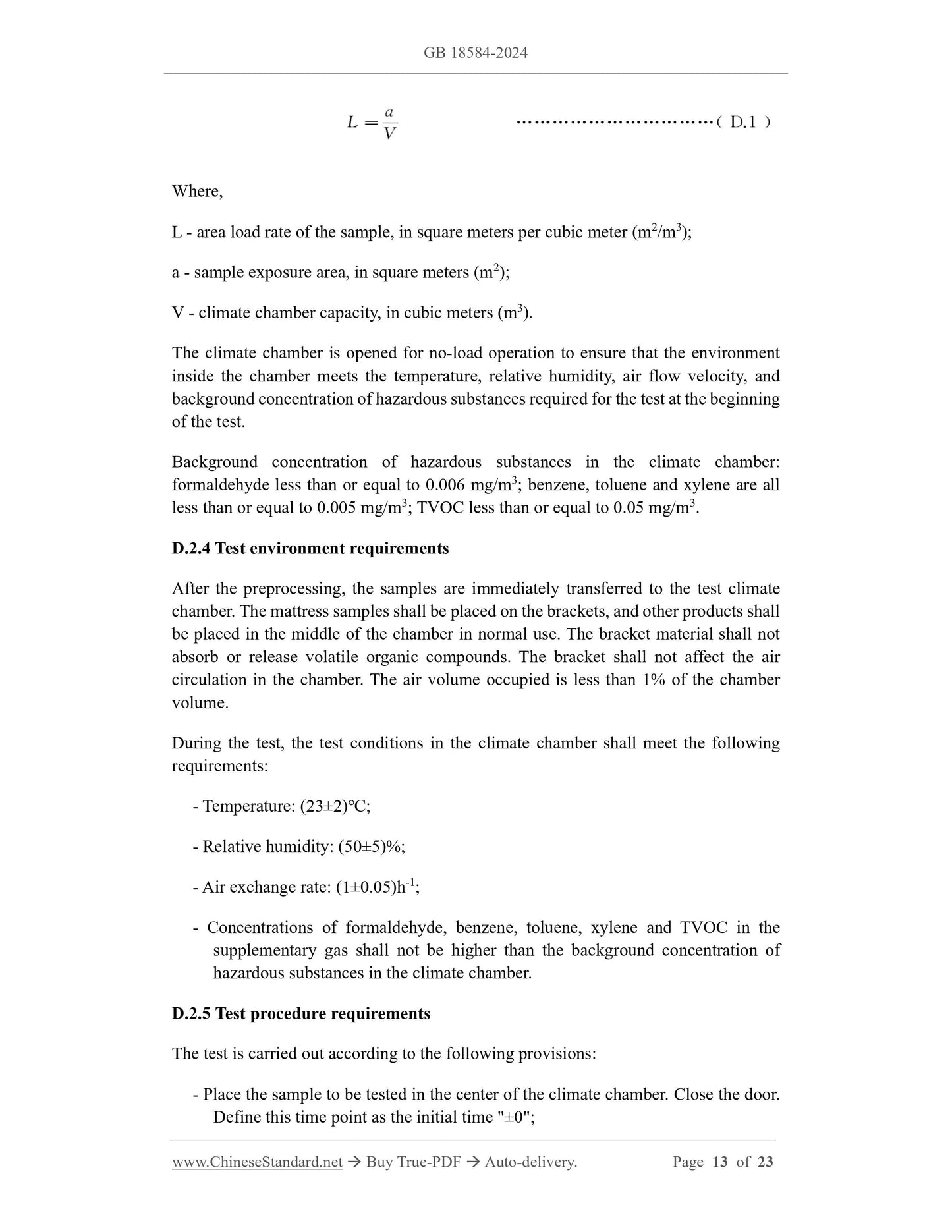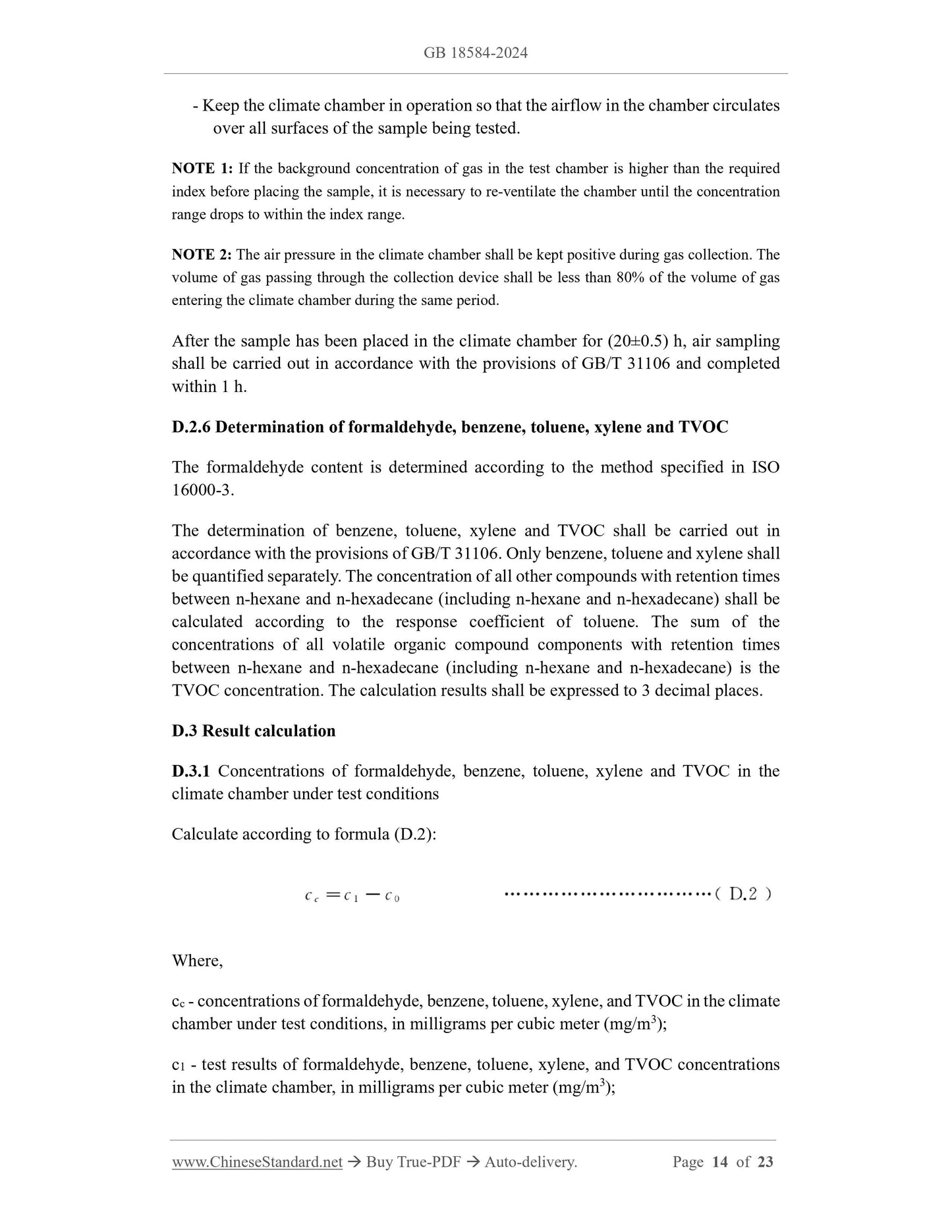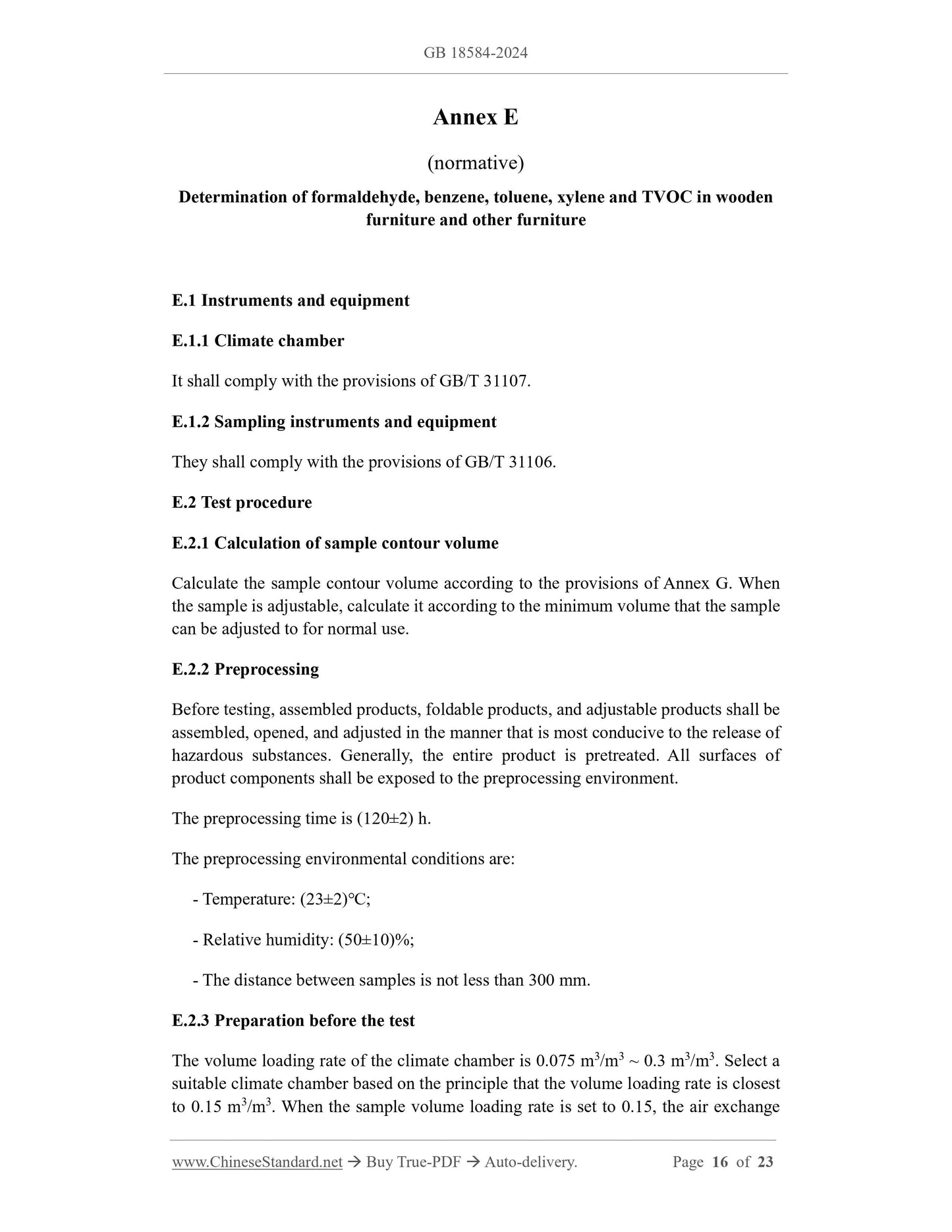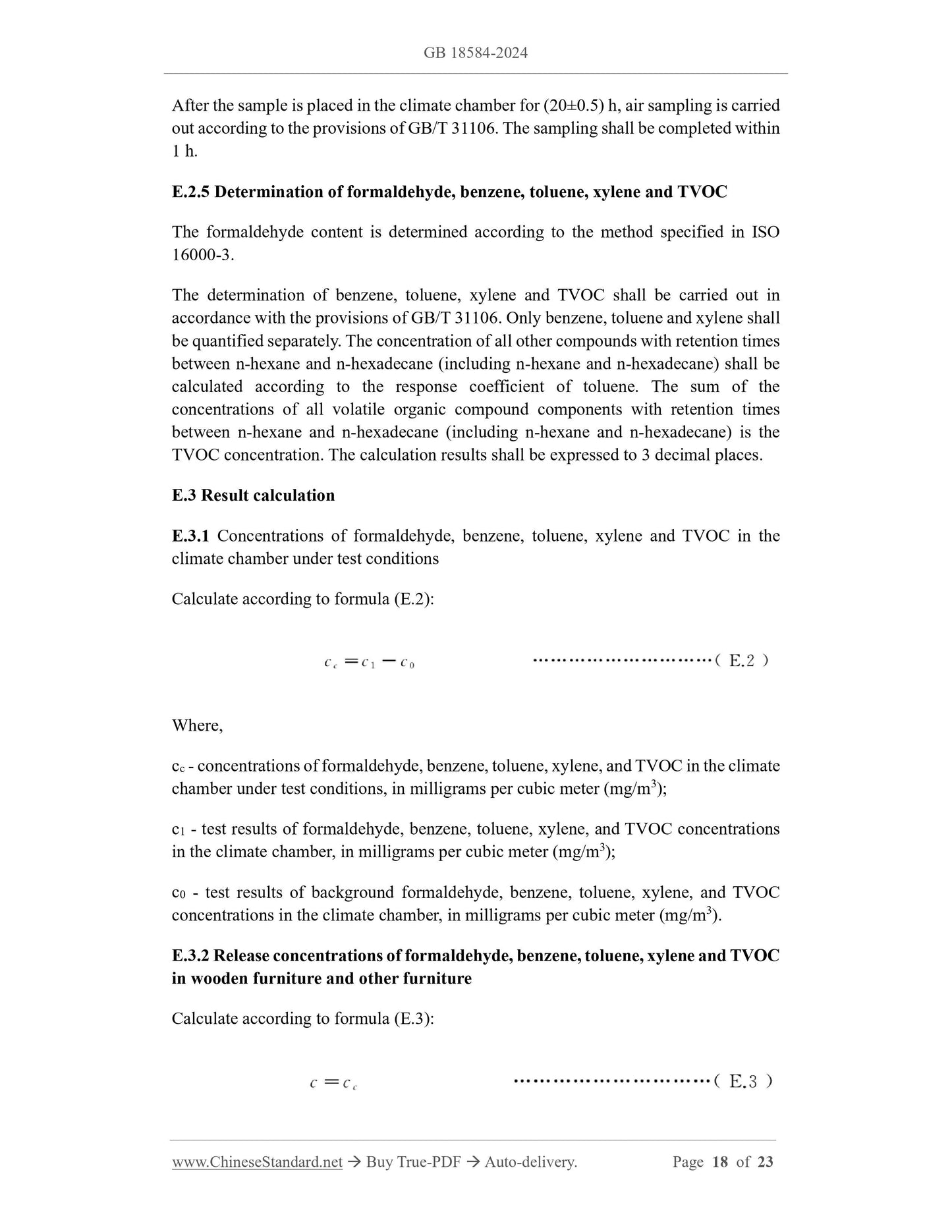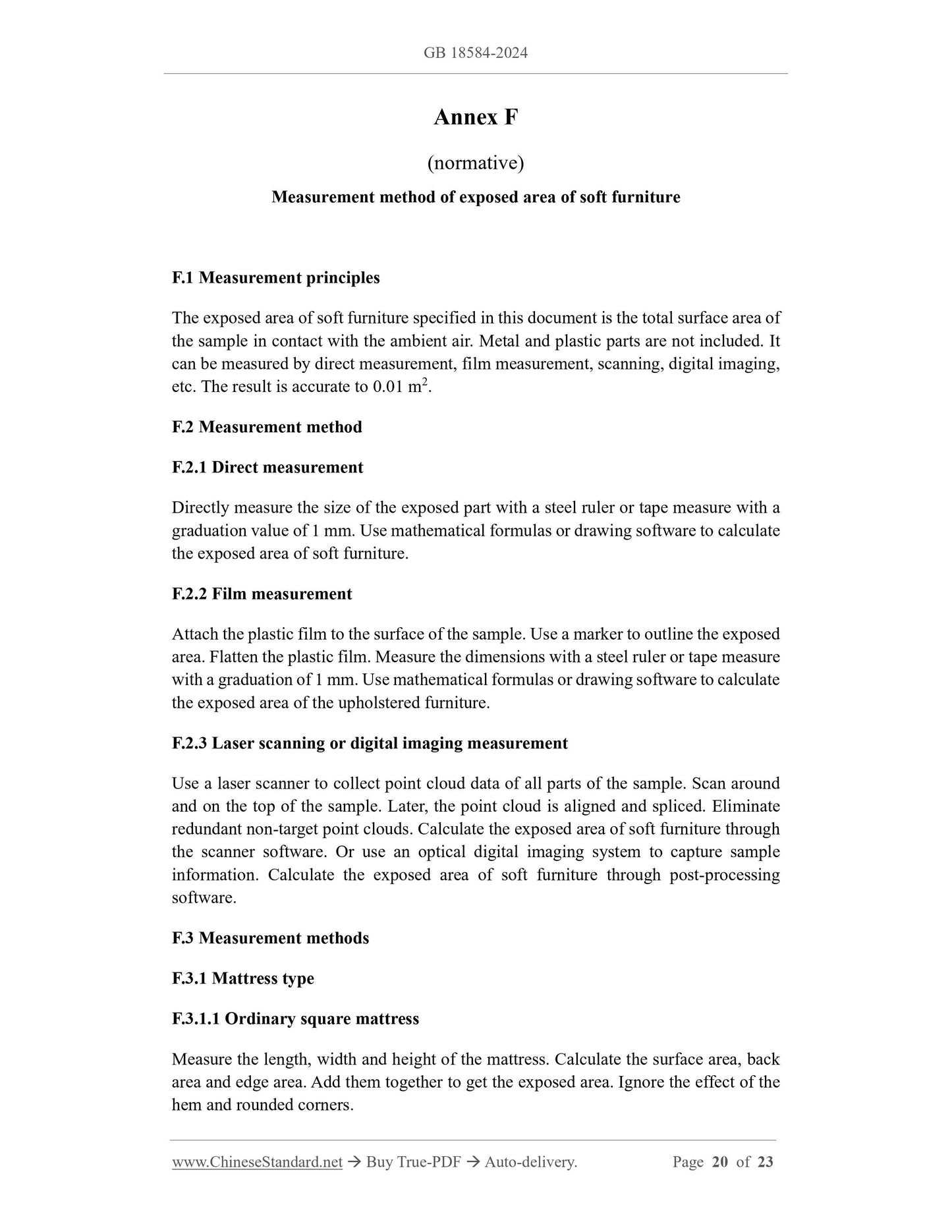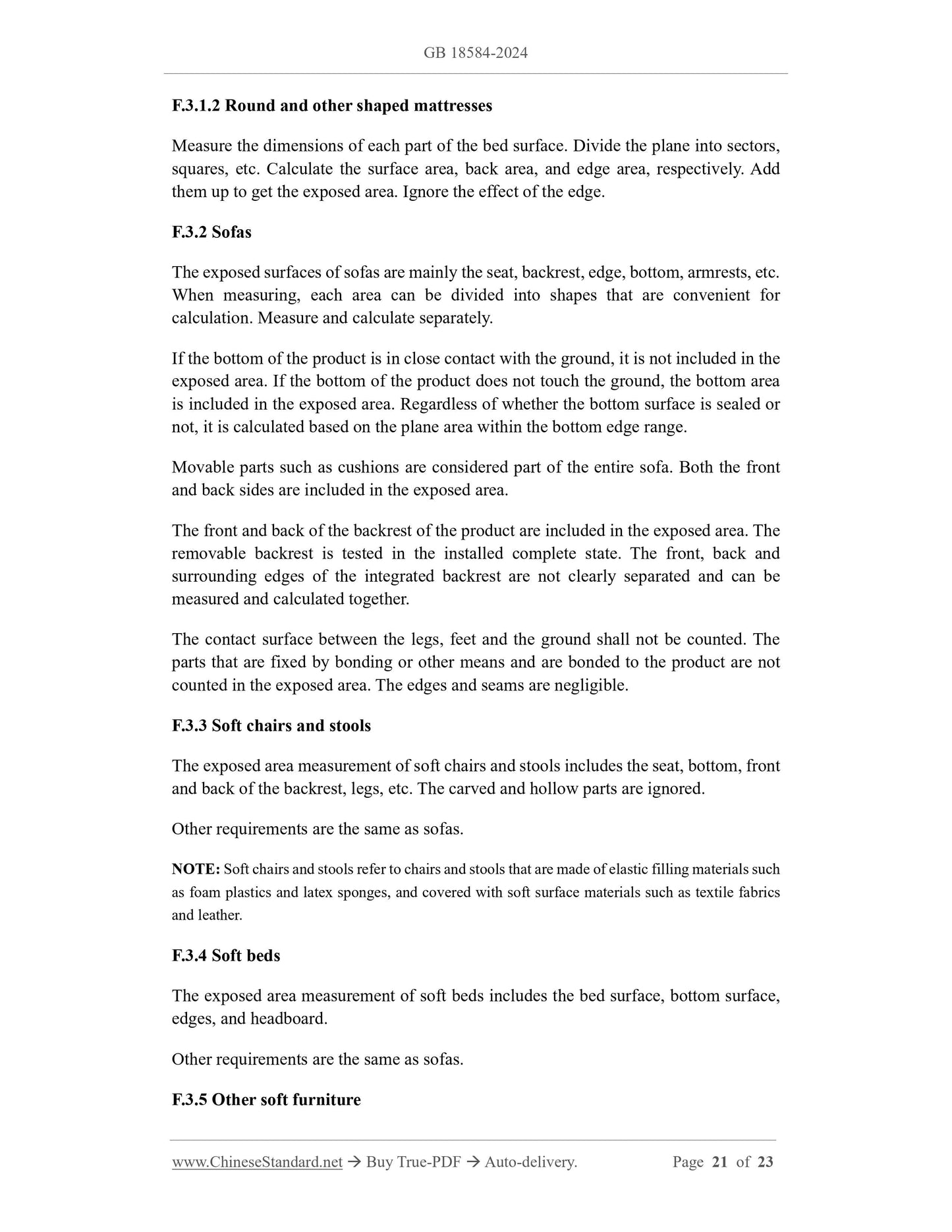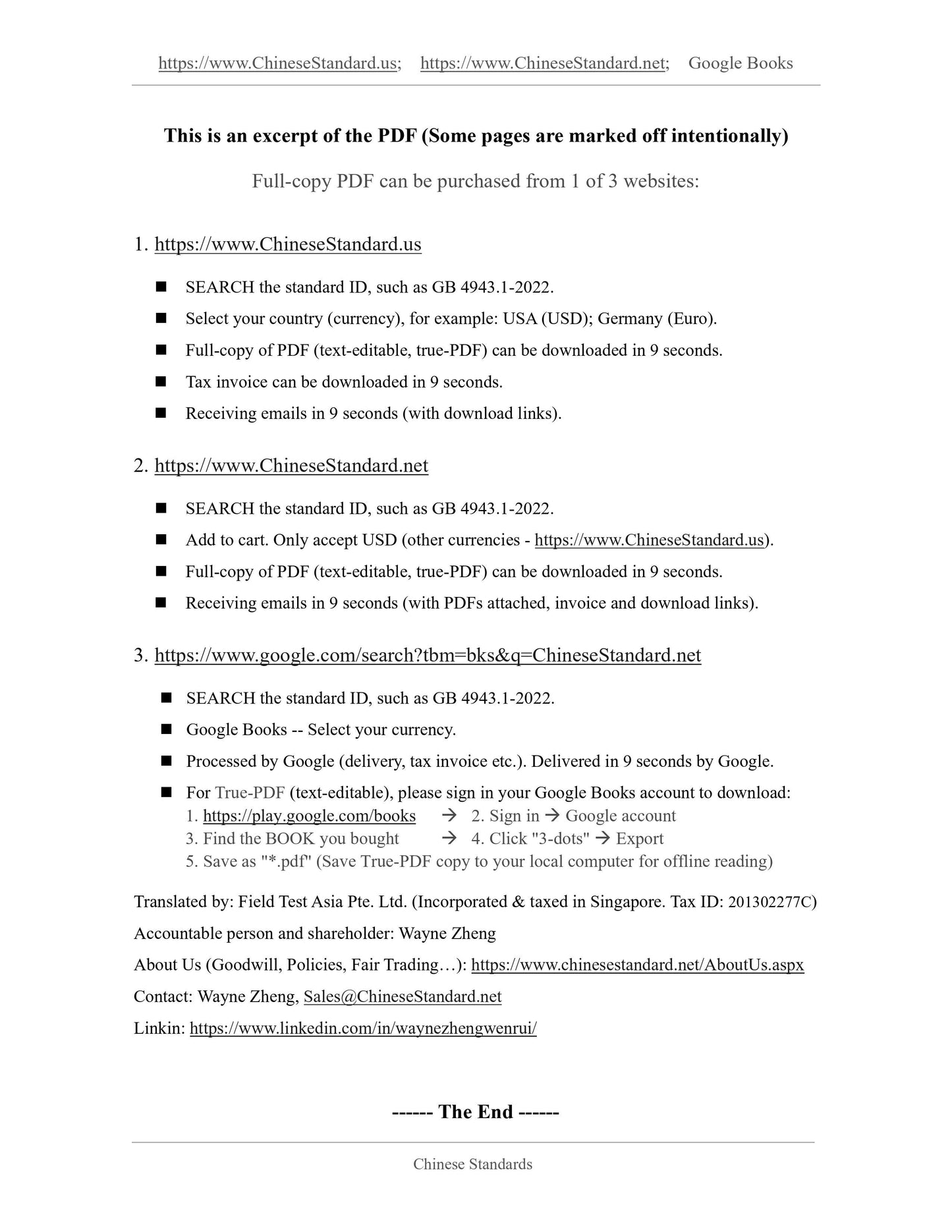1
/
of
12
PayPal, credit cards. Download editable-PDF and invoice in 1 second!
GB 18584-2024 English PDF (GB18584-2024)
GB 18584-2024 English PDF (GB18584-2024)
Regular price
$215.00 USD
Regular price
Sale price
$215.00 USD
Unit price
/
per
Shipping calculated at checkout.
Couldn't load pickup availability
Delivery: 3 seconds. Download true-PDF + Invoice.
Get QUOTATION in 1-minute: Click GB 18584-2024
Historical versions: GB 18584-2024
Preview True-PDF (Reload/Scroll if blank)
GB 18584-2024: Limit of harmful substances of furniture
GB 18584-2024
GB
NATIONAL STANDARD OF THE
PEOPLE’S REPUBLIC OF CHINA
ICS 97.140
CCS Y 80
Replacing GB 18584-2001, GB 28481-2012
Limit of hazardous substances of furniture
ISSUED ON: JUNE 25, 2024
IMPLEMENTED ON: JULY 01, 2025
Issued by: State Administration for Market Regulation;
Standardization Administration of the People's Republic of China.
Table of Contents
Foreword ... 3
1 Scope ... 5
2 Normative references ... 5
3 Terms and definitions ... 6
4 Requirements and test methods ... 7
5 Determination of test results... 8
Annex A (informative) List of phthalates ... 9
Annex B (informative) List of polycyclic aromatic hydrocarbons ... 10
Annex C (informative) List of aromatic amines that can be decomposed by
decomposable aromatic amine colourants ... 11
Annex D (normative) Determination of formaldehyde, benzene, toluene, xylene and
TVOC in soft furniture ... 12
Annex E (normative) Determination of formaldehyde, benzene, toluene, xylene and
TVOC in wooden furniture and other furniture ... 16
Annex F (normative) Measurement method of exposed area of soft furniture ... 20
Annex G (normative) Calculation of the contour volume of wooden furniture and other
furniture ... 23
Limit of hazardous substances of furniture
1 Scope
This document specifies the limit requirements and test result determination of
hazardous substances in furniture. It defines the terms and definitions and describes the
test methods.
This document applies to all types of furniture products.
2 Normative references
The following referenced documents are indispensable for the application of this
document. For dated references, only the edition cited applies. For undated references,
the latest edition of the referenced document (including any amendments) applies.
GB 6675.4-2014, Safety of toys -- Part 4: Migration of certain elements
GB/T 27717, Determination of dimethyl fumarate of furniture
GB/T 28202, Furniture industry terminology
GB/T 31106, Determination of volatile organic compounds in furniture
GB/T 31107, Environmental chamber for the determination of volatile organic
compounds of furniture -- General technical requirements
GB/T 38724, Furniture hazardous substances -- Test method for radioactivity
GB/T 40904, Methods for the determination of prohibited substances in furniture
products and related materials -- Azo dyes
GB/T 40906, Methods for the determination of prohibited substances in furniture
products and related materials -- Certain phthalate esters
GB/T 40908, Methods for the determination of prohibited substances in furniture
products and related materials -- Flame retardants
GB/T 40971, Methods for the determination of prohibited substance in furniture
products and related materials -- Polycyclic aromatic hydrocarbons
GB 28007, Technical specifications for the safety of infants and children furniture
ISO 16000-3, Indoor air -- Part 3: Determination of formaldehyde and other
carbonyl compounds in indoor and test chamber air -- Active sampling method
3 Terms and definitions
For the purposes of this document, the terms and definitions defined in GB/T 28202
and GB 28007 as well as the followings apply.
3.1 total volatile organic compounds; TVOC
Volatile organic compounds with retention times between n-hexane and n-hexadecane
are analyzed using a Tenax GC or Tenax TA sampler and a non-polar column (polarity
index less than 10).
[Source: GB/T 31106-2014, 3.2]
3.2 migrated hazardous elements
Antimony, arsenic, barium, cadmium, chromium, lead, mercury and selenium elements
measured in furniture surface coatings by prescribed test methods.
3.3 phthalates
Esters (or a series of lipid substances) formed by the reaction of phthalic acid with
alcohol.
NOTE: Its chemical structure is characterized by containing two symmetrical or asymmetrical
formic acid hydrocarbon esters at the ortho position of the benzene ring. The phthalates in this
document refer to the 6 phthalates in Annex A.
3.4 polycyclic aromatic hydrocarbons; PAH
Aromatic hydrocarbons containing two or more fused aromatic rings.
NOTE: The rings may also have short alkyl or cycloalkyl substituents. The PAHs in this document
refer to the 18 PAHs in Annex B.
3.5 decomposable aromatic amine colourants
Dyes (with azo groups) that can decompose and release one or more aromatic amines
that are or may be carcinogenic to humans in textiles or leather and fur products that
come into direct contact with the human body.
NOTE: Decomposable aromatic amine colourants in this document refer to dyes that can
decompose to produce the 24 aromatic amines listed in Annex C.
Annex D
(normative)
Determination of formaldehyde, benzene, toluene, xylene and TVOC in soft
furniture
D.1 Instruments and equipment
D.1.1 Climate chamber
It shall comply with the provisions of GB/T 31107.
D.1.2 Sampling instruments and equipment
They shall comply with the provisions of GB/T 31106.
D.2 Test procedure
D.2.1 Calculation of sample exposure area
Calculate the sample exposure area according to the provisions of Annex F. When the
sample is adjustable, calculate according to the minimum adjustable sample area.
D.2.2 Preprocessing
Before the test, measure and record the total area of the sample to be tested (exposed
area). Pre-treat the sample to be tested.
The preprocessing time is (120±2)h.
The preprocessing environmental conditions are:
- Temperature: (23±2)℃;
- Relative humidity: (50±10)%;
- The distance between samples is not less than 300 mm.
D.2.3 Preparation before the test
The load rate during the test is 0.30 m2/m3 ~ 0.70 m2/m3. The standard load rate is 0.5
m2/m3. When the sample load rate is not equal to 0.5 m2/m3, the area load rate of the
sample is calculated according to formula (D.1):
Where,
L - area load rate of the sample, in square meters per cubic meter (m2/m3);
a - sample exposure area, in square meters (m2);
V - climate chamber capacity, in cubic meters (m3).
The climate chamber is opened for no-load operation to ensure that the environment
inside the chamber meets the temperature, relative humidity, air flow velocity, and
background concentration of hazardous substances required for the test at the beginning
of the test.
Background concentration of hazardous substances in the climate chamber:
formaldehyde less than or equal to 0.006 mg/m3; benzene, toluene and xylene are all
less than or equal to 0.005 mg/m3; TVOC less than or equal to 0.05 mg/m3.
D.2.4 Test environment requirements
After the preprocessing, the samples are immediately transferred to the test climate
chamber. The mattress samples shall be placed on the brackets, and other products shall
be placed in the middle of the chamber in normal use. The bracket material shall not
absorb or release volatile organic compounds. The bracket shall not affect the air
circulation in the chamber. The air volume occupied is less than 1% of the chamber
volume.
During the test, the test conditions in the climate chamber shall meet the following
requirements:
- Temperature: (23±2)℃;
- Relative humidity: (50±5)%;
- Air exchange rate: (1±0.05)h-1;
- Concentrations of formaldehyde, benzene, toluene, xylene and TVOC in the
supplementary gas shall not be higher than the background concentration of
hazardous substances in the climate chamber.
D.2.5 Test procedure requirements
The test is carried out according to the following provis...
Get QUOTATION in 1-minute: Click GB 18584-2024
Historical versions: GB 18584-2024
Preview True-PDF (Reload/Scroll if blank)
GB 18584-2024: Limit of harmful substances of furniture
GB 18584-2024
GB
NATIONAL STANDARD OF THE
PEOPLE’S REPUBLIC OF CHINA
ICS 97.140
CCS Y 80
Replacing GB 18584-2001, GB 28481-2012
Limit of hazardous substances of furniture
ISSUED ON: JUNE 25, 2024
IMPLEMENTED ON: JULY 01, 2025
Issued by: State Administration for Market Regulation;
Standardization Administration of the People's Republic of China.
Table of Contents
Foreword ... 3
1 Scope ... 5
2 Normative references ... 5
3 Terms and definitions ... 6
4 Requirements and test methods ... 7
5 Determination of test results... 8
Annex A (informative) List of phthalates ... 9
Annex B (informative) List of polycyclic aromatic hydrocarbons ... 10
Annex C (informative) List of aromatic amines that can be decomposed by
decomposable aromatic amine colourants ... 11
Annex D (normative) Determination of formaldehyde, benzene, toluene, xylene and
TVOC in soft furniture ... 12
Annex E (normative) Determination of formaldehyde, benzene, toluene, xylene and
TVOC in wooden furniture and other furniture ... 16
Annex F (normative) Measurement method of exposed area of soft furniture ... 20
Annex G (normative) Calculation of the contour volume of wooden furniture and other
furniture ... 23
Limit of hazardous substances of furniture
1 Scope
This document specifies the limit requirements and test result determination of
hazardous substances in furniture. It defines the terms and definitions and describes the
test methods.
This document applies to all types of furniture products.
2 Normative references
The following referenced documents are indispensable for the application of this
document. For dated references, only the edition cited applies. For undated references,
the latest edition of the referenced document (including any amendments) applies.
GB 6675.4-2014, Safety of toys -- Part 4: Migration of certain elements
GB/T 27717, Determination of dimethyl fumarate of furniture
GB/T 28202, Furniture industry terminology
GB/T 31106, Determination of volatile organic compounds in furniture
GB/T 31107, Environmental chamber for the determination of volatile organic
compounds of furniture -- General technical requirements
GB/T 38724, Furniture hazardous substances -- Test method for radioactivity
GB/T 40904, Methods for the determination of prohibited substances in furniture
products and related materials -- Azo dyes
GB/T 40906, Methods for the determination of prohibited substances in furniture
products and related materials -- Certain phthalate esters
GB/T 40908, Methods for the determination of prohibited substances in furniture
products and related materials -- Flame retardants
GB/T 40971, Methods for the determination of prohibited substance in furniture
products and related materials -- Polycyclic aromatic hydrocarbons
GB 28007, Technical specifications for the safety of infants and children furniture
ISO 16000-3, Indoor air -- Part 3: Determination of formaldehyde and other
carbonyl compounds in indoor and test chamber air -- Active sampling method
3 Terms and definitions
For the purposes of this document, the terms and definitions defined in GB/T 28202
and GB 28007 as well as the followings apply.
3.1 total volatile organic compounds; TVOC
Volatile organic compounds with retention times between n-hexane and n-hexadecane
are analyzed using a Tenax GC or Tenax TA sampler and a non-polar column (polarity
index less than 10).
[Source: GB/T 31106-2014, 3.2]
3.2 migrated hazardous elements
Antimony, arsenic, barium, cadmium, chromium, lead, mercury and selenium elements
measured in furniture surface coatings by prescribed test methods.
3.3 phthalates
Esters (or a series of lipid substances) formed by the reaction of phthalic acid with
alcohol.
NOTE: Its chemical structure is characterized by containing two symmetrical or asymmetrical
formic acid hydrocarbon esters at the ortho position of the benzene ring. The phthalates in this
document refer to the 6 phthalates in Annex A.
3.4 polycyclic aromatic hydrocarbons; PAH
Aromatic hydrocarbons containing two or more fused aromatic rings.
NOTE: The rings may also have short alkyl or cycloalkyl substituents. The PAHs in this document
refer to the 18 PAHs in Annex B.
3.5 decomposable aromatic amine colourants
Dyes (with azo groups) that can decompose and release one or more aromatic amines
that are or may be carcinogenic to humans in textiles or leather and fur products that
come into direct contact with the human body.
NOTE: Decomposable aromatic amine colourants in this document refer to dyes that can
decompose to produce the 24 aromatic amines listed in Annex C.
Annex D
(normative)
Determination of formaldehyde, benzene, toluene, xylene and TVOC in soft
furniture
D.1 Instruments and equipment
D.1.1 Climate chamber
It shall comply with the provisions of GB/T 31107.
D.1.2 Sampling instruments and equipment
They shall comply with the provisions of GB/T 31106.
D.2 Test procedure
D.2.1 Calculation of sample exposure area
Calculate the sample exposure area according to the provisions of Annex F. When the
sample is adjustable, calculate according to the minimum adjustable sample area.
D.2.2 Preprocessing
Before the test, measure and record the total area of the sample to be tested (exposed
area). Pre-treat the sample to be tested.
The preprocessing time is (120±2)h.
The preprocessing environmental conditions are:
- Temperature: (23±2)℃;
- Relative humidity: (50±10)%;
- The distance between samples is not less than 300 mm.
D.2.3 Preparation before the test
The load rate during the test is 0.30 m2/m3 ~ 0.70 m2/m3. The standard load rate is 0.5
m2/m3. When the sample load rate is not equal to 0.5 m2/m3, the area load rate of the
sample is calculated according to formula (D.1):
Where,
L - area load rate of the sample, in square meters per cubic meter (m2/m3);
a - sample exposure area, in square meters (m2);
V - climate chamber capacity, in cubic meters (m3).
The climate chamber is opened for no-load operation to ensure that the environment
inside the chamber meets the temperature, relative humidity, air flow velocity, and
background concentration of hazardous substances required for the test at the beginning
of the test.
Background concentration of hazardous substances in the climate chamber:
formaldehyde less than or equal to 0.006 mg/m3; benzene, toluene and xylene are all
less than or equal to 0.005 mg/m3; TVOC less than or equal to 0.05 mg/m3.
D.2.4 Test environment requirements
After the preprocessing, the samples are immediately transferred to the test climate
chamber. The mattress samples shall be placed on the brackets, and other products shall
be placed in the middle of the chamber in normal use. The bracket material shall not
absorb or release volatile organic compounds. The bracket shall not affect the air
circulation in the chamber. The air volume occupied is less than 1% of the chamber
volume.
During the test, the test conditions in the climate chamber shall meet the following
requirements:
- Temperature: (23±2)℃;
- Relative humidity: (50±5)%;
- Air exchange rate: (1±0.05)h-1;
- Concentrations of formaldehyde, benzene, toluene, xylene and TVOC in the
supplementary gas shall not be higher than the background concentration of
hazardous substances in the climate chamber.
D.2.5 Test procedure requirements
The test is carried out according to the following provis...
Share
